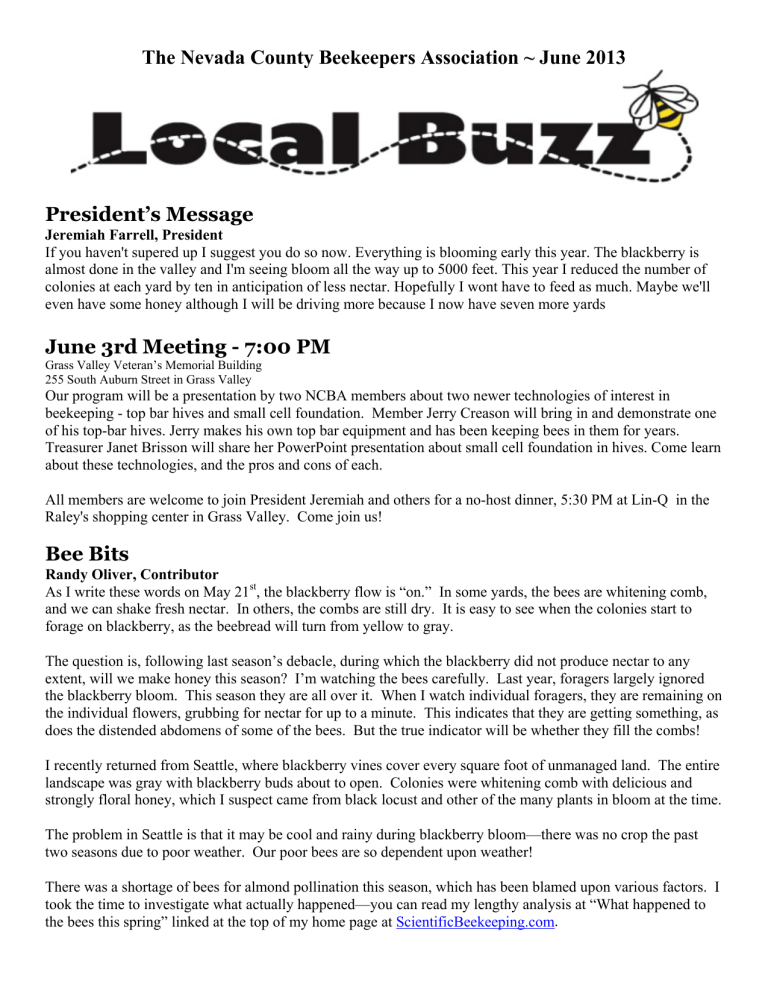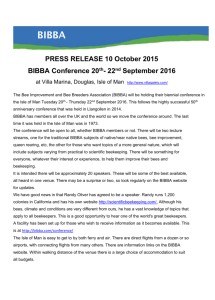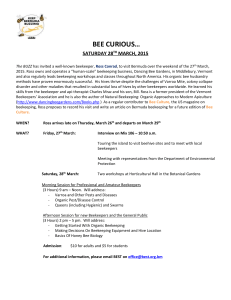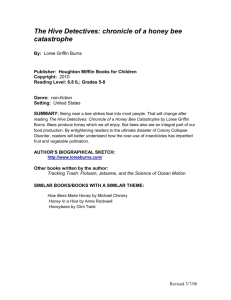June 2013 The Local Buzz - Nevada County Beekeepers Association

The Nevada County Beekeepers Association ~ June 2013
President’s Message
Jeremiah Farrell, President
If you haven't supered up I suggest you do so now. Everything is blooming early this year. The blackberry is almost done in the valley and I'm seeing bloom all the way up to 5000 feet. This year I reduced the number of colonies at each yard by ten in anticipation of less nectar. Hopefully I wont have to feed as much. Maybe we'll even have some honey although I will be driving more because I now have seven more yards
June 3rd Meeting - 7:00 PM
Grass Valley Veteran’s Memorial Building
255 South Auburn Street in Grass Valley
Our program will be a presentation by two NCBA members about two newer technologies of interest in beekeeping - top bar hives and small cell foundation. Member Jerry Creason will bring in and demonstrate one of his top-bar hives. Jerry makes his own top bar equipment and has been keeping bees in them for years.
Treasurer Janet Brisson will share her PowerPoint presentation about small cell foundation in hives. Come learn about these technologies, and the pros and cons of each.
All members are welcome to join President Jeremiah and others for a no-host dinner, 5:30 PM at Lin-Q in the
Raley's shopping center in Grass Valley. Come join us!
Bee Bits
Randy Oliver, Contributor
As I write these words on May 21 st
, the blackberry flow is “on.” In some yards, the bees are whitening comb, and we can shake fresh nectar. In others, the combs are still dry. It is easy to see when the colonies start to forage on blackberry, as the beebread will turn from yellow to gray.
The question is, following last season’s debacle, during which the blackberry did not produce nectar to any extent, will we make honey this season? I’m watching the bees carefully. Last year, foragers largely ignored the blackberry bloom. This season they are all over it. When I watch individual foragers, they are remaining on the individual flowers, grubbing for nectar for up to a minute. This indicates that they are getting something, as does the distended abdomens of some of the bees. But the true indicator will be whether they fill the combs!
I recently returned from Seattle, where blackberry vines cover every square foot of unmanaged land. The entire landscape was gray with blackberry buds about to open. Colonies were whitening comb with delicious and strongly floral honey, which I suspect came from black locust and other of the many plants in bloom at the time.
The problem in Seattle is that it may be cool and rainy during blackberry bloom—there was no crop the past two seasons due to poor weather. Our poor bees are so dependent upon weather!
There was a shortage of bees for almond pollination this season, which has been blamed upon various factors. I took the time to investigate what actually happened—you can read my lengthy analysis at “What happened to the bees this spring” linked at the top of my home page at ScientificBeekeeping.com
.
We were surprised yesterday by a couple of yards of bees headed by last year’s queens. To our surprise, they had swarmed heavily, but nearly half did not successfully requeen! You may wish to check your own hives for the presence of young brood.
This spring I saw far more European Foulbrood (EFB) than usual, and am still seeing some in a few colonies.
The current strain of EFB does not “disappear” as it used to with the start of a good pollen flow. It is also very easy to miss! If the brood pattern in a hive is spotty, I would certainly suspect EFB. The problem is that the workers remove sick larvae before they develop field signs—discoloration and twisting in the cells. Many beekeepers will miss diagnosis. If you have a colony with spotty brood, an uneven age distribution of larvae in the cells, and that is building up poorly, I would suspect EFB.
Although I do not recommend routine treatment with antibiotics, EFB is pretty easily cleared up with oxytetracycline antibiotic. Note that oxytetracycline is a completely “natural” product, produced by the soil bacterium Streptomyces rimosus .
If you have not yet supered your hives for honey, now is your last chance. Good luck this season!
Bee Hydration
Diane Benton, Contributor
Does your neighbor have bees in her fountain?
Or in her dog’s water bowl, or the kid’s wading pool? Are they your bees? Remember when you took Randy’s beekeeping class and he said “make you’re your bees have a running water source nearby.” I’ve been using this solar powered pump for two years now in an old horse trough but it is small enough to use in a bucket. I ordered mine from Harbor Freight online for $17.99 or you can go to their store in Roseville just off Stanford
Ranch Rd. (Costco, Home Depot area). Don’t forget to put a few sticks in your bucket for the bees to land on.
Groups sue EPA over honeybee deaths
By Carey Gillam, Reuters
A lawsuit filed on Thursday charges that U.S. environmental regulators are failing to protect honeybees and their role in pollinating important food crops, and should immediately suspend use of some toxic insecticides tied to the widespread deaths of the bees,
"It is a catastrophe in progress," said migratory beekeeper Steve Ellis who maintains 2,000 bee hives for pollinating crops from Minnesota to California. "We have an ongoing problem that is worsening."
Full story at nbcnews.com
Country Rubes Combo Screened
Bottom Boards
Special NCBA Club Price! Call Janet for details. 530-
913-2724 or rubes@countryrubes.com
Honey Extraction House
A to Z Supply has a honey extraction house available for rent. Equipment is provided and the room is heated and there's lots of hot water for clean up. For more information: 530.273.6608
-----------------------------------------------------------------------------
Advertising space (3” by 2”) is available here and need not be bee-related. Advertising rates are $7 per year for NCBA members and $16 per year for non-members.
Sacramento Beekeeping Supplies
Complete line of all beekeeping supplies
American dealer for Sheriff suits
Gifts—bee themed children’s wear, tableware, garden décor
Books—children’s beekeeping, homemade cosmetics, candles
Beeswax candles, molds, waxes, dyes, scents, and wicks
Honeycomb sheets for rolling candles—35 colors
2110 X Street, Sacramento, CA 95818
(916) 451-2337 fax (916) 451-7008
Webpage at www.sacramentobeekeeping.com/ email: info@sacramentobeekeeping.com
Open Tuesday through Saturday 10:00 – 5:30
Mail Orders Receive Quick Service
Minutes from Last Meeting
Jack Meeks, Secretary
Sorry I missed the meeting, as did J. Farrell.
The program was "Meadmaking" with Tom Harper and Julia Boronakis Harper. They talked about how they make mead from their own honey at the Boronakis-Harper Ranch in Auburn, CA
Leslie Gault presided.
FINANCE J Brisson
Feb Begin Bal $3338.13; Inc $521.70; Feb End $3859.83
March Begin Bal $3859.83; Inc $460.70; March End $4320.55.
Raffle Prizes
Karla Hanson, Coordinator
Thank you all for bringing some great items for our raffles, keep it coming. Plants, eggs, jewelry, soaps, bee items, jams, beautiful metal garden art, the list goes on and on... Thanks to everyone!
From the Librarian
Tynowyn Slattery, Librarian
A new book...
Home Grown Honey Bees: An absolute Beginner's Guide
Alethea Morrison, Photography by Mars Vilaubi
Storey Publishing 2013
159 pages
This is on Randy's class reading list and a welcome addition to our growing section of, "how-to keep bees".
The lay out, as in most of these books, follows the year, from spring nucs to the, hoped for, honey harvest. An approach that is traditional with most authors on the subject, but lately, more and more authors are breaking chapters up with "sound bites", addressing some relevant, important or even peripheral questions by lifting them out of the text into boxes or side bars; this works best with a good index, which this book has, even the name of the indexer has been included, which is a nice touch.
In fact, organization is one of the pluses here, with an appendix on parasites, diseases & ailments, a resources section and a 2 page glossary, but all this information never gets as numbing as it could as there has been a great deal of attention given to an artistic lay-out and the pictures which were, for the greater part, taken by the author's husband, are many and excellent. One picture of a powdered sugar covered bee gives a distinct personality to one of the 30,000 - 60,000 inhabitants of the hive, I could really relate.
A special feature in the writing is the warm tone and encouragement offered in those areas that turn the learning curve of the first year into a real slippery slope.
No doubt you will want to go on to read some of the more detailed beginner's guides that we have in the library, but this book is a great way to begin and this is the book that I will recommend to those who say they don't intend to keep bees but, "...want to know all about them."
We also have another book on Randy's list, Honey Bee Hobbyist; it arrived too late to review but it is available for check out, I'll review it next month.
Mediaeval picture of Cupid running to his mom Venus after messing with a hive. (that'll teach him!)
An Idea for Beekeeper Research Funding
By Randy Oliver
Project Apis m (PAm) is a six-year old nonprofit established to fund beekeeping research, using donations from beekeepers, almond growers, and grants from organizations such as Häagen-Dazs and recently, Monsanto (a large grant to develop bee forage on ag lands). To date, PAm has funded some 40 projects to the tune of $2.4 million. The results have been presented at the national beekeeping conventions and published in scientific journals.
We recently had five excellent proposals submitted, but do not have enough cash on hand to fund them all. I suggested that we try "crowdsourcing" to come up with the funds, targeting all the small beekeeping clubs. I'm guessing that there are somewhere between 100 and 1000 such clubs in the U.S. If each club were to donate
$500, that would generate some serious money for bee research!
Many members of the List belong to local beekeeping clubs. I'm asking you to put a request to donate to PAm on the agenda of your next meeting.
The current research projects that we'd like to fund are:
1. A continuation of the pesticide analysis cost-share program run by Dr. Maryann Frazier. PAm donates $100 to offset part of the cost of testing each bee or pollen sample submitted by beekeepers for pesticide analysis.
This information is then put into a database for use by researchers, beekeepers, and EPA (cost $15,000).
2. Following upon his research of last year, Dr. Reed Johnson has a proposal to test for the effects of the fungicides and insect growth regulators used during almond bloom upon the development of worker and queen brood. The expense of pesticide analyses runs the cost up to $134,000.
3. Dr. Brian Johnson has proposed to validate the accuracy of the IVDS machine (developed by Dr. Charles
Wick) at identifying bee viruses. If validated, the IVDS machine would allow rapid and inexpensive virus analysis for beekeepers and researchers (a number of us currently send samples for analysis)
($34,755)
.
4. Dr. David Tarpy has a one-time chance to purchase a refurbished machine that will allow him to rapidly and cheaply determine the viability of semen in queens and drones. This will allow him to work with the Bee
Informed Partnership to try to figure out why so many beekeepers are reporting queen problems
($29,480)
.
5. And finally, Dr. Jonathan Engelsma is trying to set up a pilot project using a hive scale network across the country to track and model colony survivorship and disease outbreaks based on real-time hive weight data
($22,140)
.
Your bee club could either give an unrestricted donation, which would go toward funding of any or all of the above, or you could specify which project(s) you support. PAm is also happy to receive donations from businesses that support honey bee research--please be creative in helping us to fund these researchers!
The Nevada County Beekeepers Association is dedicated to apiculture education and promotion of the art and science of beekeeping among beekeepers, agriculturists, and the general public. This is a “not for profit” organization. Donations are welcomed.
Meetings are held the first Monday of each month at 7 PM at the Grass
Valley Veteran’s Memorial Building at 255 South Auburn Street in
Grass Valley. All visitors are welcome. Use the back entrance.
The newsletter is published monthly as a service to the membership.
Articles, recipes, commentary, and news items are welcomed and encouraged. Contributions should be received by the 20th of the Month to be included into the next issue. Submit to garyg@newpress.com
Advertising space (3” by 2”) in this newsletter is usually available and
need not be bee-related. Advertising rates are $7 per year for NCBA members and $16 per year for non-members.
Nevada County Beekeepers Association
Nevada County Beekeepers Association
Officers
President: Jeremiah Farrell ………..….. 632-3303
Vice President: Leslie Gault .....................346-7092
Secretary: Jack Meeks….……... 432-4429 jackm@nccn.net
Treasurer: Janet Brisson........… 913-2724 rubes@countryrubes.com
Board Members
Larry Merritt………. 613-3923 lameritt@theunion.net
Randy Oliver……… 277-4450
Charlie Whittlesey.....292-3249 or 755-0468
Deborah Morawski…675-2924
Karla Hanson…...…. 265-3756
Committee Chairs
Swarm Hotline: Karla Hanson…....…. 265-3756
Lynn Williams …..… 675-2924
Librarian: Tynowyn Slattery...... 265-6318
Newsletter Mailing: Steve Reynolds.....…. 268-2133
Newsletter: Gary Gustafson.......... 478-1216
Honey Extractor: Karla Hanson…...….. 265-3756
c/o Steve Reynolds
10838 Ridge Road
Nevada City, CA 95959
First Class Mail
June 3rd Meeting - 7PM
Program:
Top bar hives and small cell foundation
No host dinner at Lin-Q - 5:30PM






